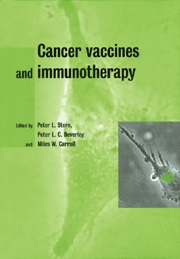Book contents
- Frontmatter
- Contents
- List of contributors
- 1 Immunity and cancer
- 2 Immunotherapy of bladder cancer
- 3 Poxviruses as vectors for cancer immunotherapy
- 4 Vaccinia-based human papillomavirus vaccines in cervical cancer
- 5 Vaccine delivery and immunosuppression in cervical cancer
- 6 Vaccines for colon cancer
- 7 MUC1 vaccines and breast cancer
- 8 Anti-idiotypic vaccination
- 9 Immunotherapy and vaccination against Epstein–Barr virus-associated cancer
- 10 Serologically identified tumour antigens as cancer vaccines
- 11 CTL-defined cancer vaccines in melanoma and other epithelial cancers
- 12 DNA vaccines against B-cell tumours
- 13 Dendritic cell approaches to immunotherapy
- 14 Overview
- 15 Recent developments
- Index
4 - Vaccinia-based human papillomavirus vaccines in cervical cancer
Published online by Cambridge University Press: 06 January 2010
- Frontmatter
- Contents
- List of contributors
- 1 Immunity and cancer
- 2 Immunotherapy of bladder cancer
- 3 Poxviruses as vectors for cancer immunotherapy
- 4 Vaccinia-based human papillomavirus vaccines in cervical cancer
- 5 Vaccine delivery and immunosuppression in cervical cancer
- 6 Vaccines for colon cancer
- 7 MUC1 vaccines and breast cancer
- 8 Anti-idiotypic vaccination
- 9 Immunotherapy and vaccination against Epstein–Barr virus-associated cancer
- 10 Serologically identified tumour antigens as cancer vaccines
- 11 CTL-defined cancer vaccines in melanoma and other epithelial cancers
- 12 DNA vaccines against B-cell tumours
- 13 Dendritic cell approaches to immunotherapy
- 14 Overview
- 15 Recent developments
- Index
Summary
Introduction
The Poxviridae are a family of double-stranded DNA viruses that characteristically replicate in the cytoplasm of infected cells and, by encoding a wide range of hostindependent enzymes, are able to express gene products and replicate DNA, even in enucleated cells. They are further subclassified but only two members of the subfamily Chordopoxviridae (poxviruses of vertebrates), molluscum contagiosum virus and variola (smallpox), are specifically human viruses. Infection with poxviruses of other species can occur with cowpox, vaccinia and monkeypox, sometimes resulting in localized outbreaks. In addition, skin infections from inadvertent local inoculation with orf (a virus of sheep and goats), pseudocowpox (producing milker's nodules), tannapox and yabapoxvirus occur. The most notorious member of this family – variola virus – was historically the cause of widespread pandemics of smallpox. It is estimated that 400000 people died each year in Europe at the turn of the eighteenth century with a consequent major impact on communities. Clinically, it has been recognized that immunity was lifelong following exposure to variola, resulting in the practice of variolation (direct inoculation of infected scabs from patients into healthy recipients). Although immunity to variola and a significant reduction in mortality was achieved, a substantial morbidity and mortality associated with the procedure remained. This provided the background to the classical experiments of Jenner, who used direct inoculation of cowpox to induce protective immunity to experimental exposure to variola.
- Type
- Chapter
- Information
- Cancer Vaccines and Immunotherapy , pp. 62 - 81Publisher: Cambridge University PressPrint publication year: 2000



